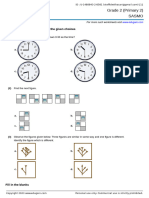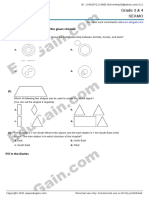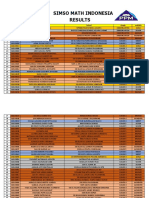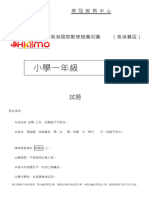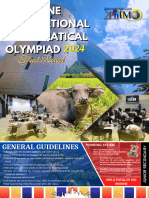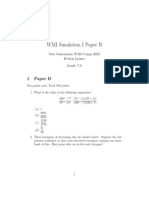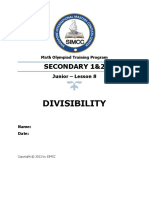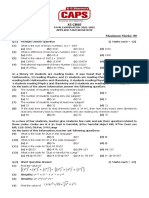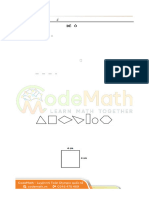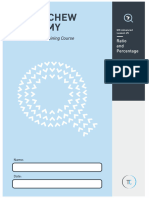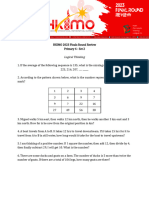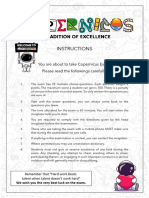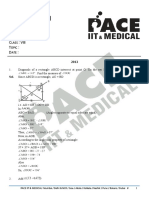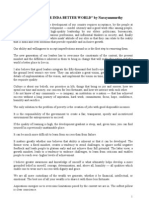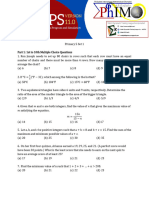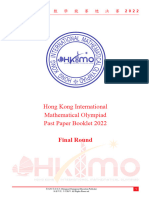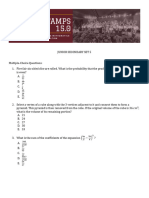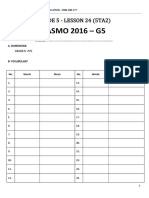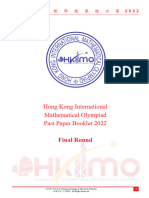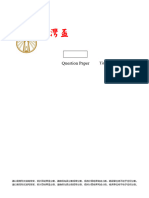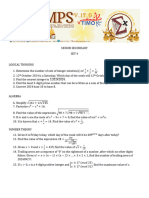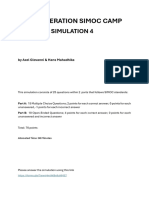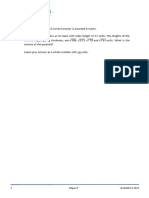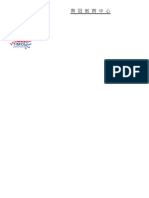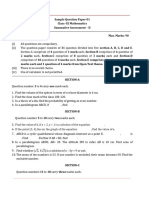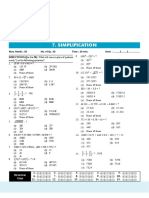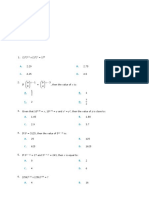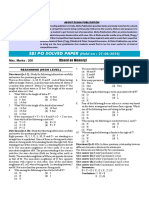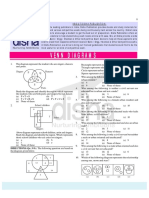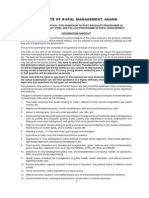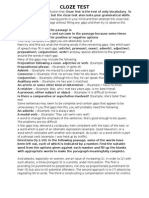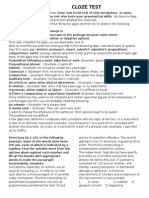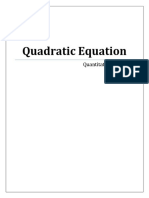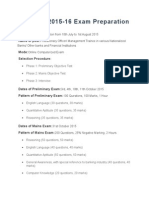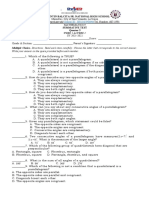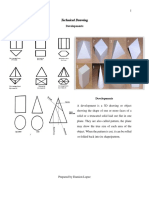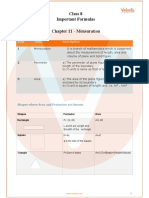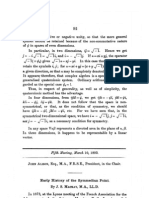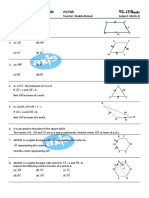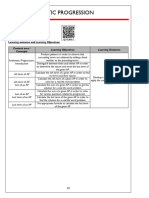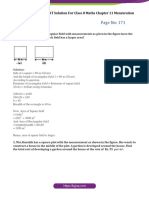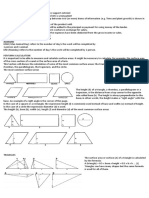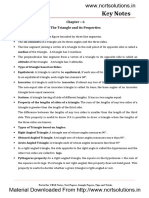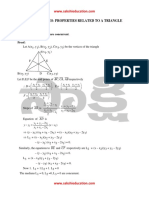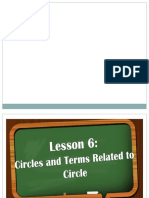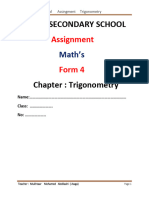Solution: - Let A Involves 30 Units, B Involves 15 Units and C Involves 20 Units of Work
Solution: - Let A Involves 30 Units, B Involves 15 Units and C Involves 20 Units of Work
Uploaded by
Ajeet Singh RachhoyaCopyright:
Available Formats
Solution: - Let A Involves 30 Units, B Involves 15 Units and C Involves 20 Units of Work
Solution: - Let A Involves 30 Units, B Involves 15 Units and C Involves 20 Units of Work
Uploaded by
Ajeet Singh RachhoyaOriginal Description:
Original Title
Copyright
Available Formats
Share this document
Did you find this document useful?
Is this content inappropriate?
Copyright:
Available Formats
Solution: - Let A Involves 30 Units, B Involves 15 Units and C Involves 20 Units of Work
Solution: - Let A Involves 30 Units, B Involves 15 Units and C Involves 20 Units of Work
Uploaded by
Ajeet Singh RachhoyaCopyright:
Available Formats
MOCK1
Q.1 A welder can finish job A and job C in 10 days and 20 days respectively. A blacksmith can finish job B and job C in 15 days and 10 days respectively. On the first day, two welders begin work on job A and a day later three blacksmiths begin work on job B. What is the least time required to complete all the three jobs? (a)33/4 days (b) 37 /4 days (c)31/4 days (d) None of these Solution: - Let A involves 30 units, B involves 15 units and C involves 20 units of work. One welder does 3 units of A and 1 unit of C in a day. One blacksmith does 1 unit of B and 2 units of C in a day. Two welders would take 5 days to complete A. They finish A at the end of day 5. On day 6 they finish 2 units of C. Three blacksmiths finish B at the end of day 6. After days 6, two welders and three blacksmiths together would take 18/8 days to finish the rest of C. So in all it takes 33/4 days to complete all the jobs. Q.2 In the given figure ABCD is a quadrilateral with BC = 4 cm and AD = 2 cm.
What is the length of AB (in cm)? a) 4 (1/_/3) b) ( 4_/3 2) / _/3
c) ( 2_/3 + 1 ) / 2
d) (2_/3 -1) / 2
Solution: - extend AB and CD and meet at point E so now triangle ABC an equilateral triangle formed. So BE = EC = BC =4 And triangle EAD is a right angle triangle (30,60,90) So ratio of sides will be 1 : _/3 : 2 If AD = 2 then AE will be ( 2 / _/3)
So length of AB = BE AE = 4 - (2 / _/3)
Q,3 In how many ways can 4 distinct balls be distributed into 3 identical boxes? (a) 14 (b) 17 (c) 11 (d) 6
Solution :Case 1: All four balls in the same box: 1 way Since all the boxes are identical. Case 2: Two balls in 1 box and the remaining two in another box: 4 C2 / 2! = 3 ways It is divided by 2! because the boxes are identical. Case 3: Two balls in a box and one ball in each of the remaining two boxes: 4 C2 = 6 ways Note: We need not select a box for the remaining two balls as they will go one each in the remaining two boxes in one way only. Case 4: Three balls in one box and one remaining ball in another box: 4 = C3 = 4 ways Since there is only one way of selecting the other box as the boxes are identical. Total ways = 1 + 3 + 6 + 4 = 14
Q.4) In the figure given below, OMN is an octant of a circle having centre at O. ABCD is a rectangle with AD = 6 and AB = 2. Find area of the octant of the circle
A) 8
B) 8.5
C) 12
D) 10
E) 12.5
SOLUTION: - Join OC. In triangle OAD; angle O =45 deg (octant of a circle) so, angle D= 45 as angle A = 90 deg. hence, OA=OD=6 In triangle OBC: OC is radius R, OB=OA+AB = 8 , **= 6 applying Pythagoras R= 10 therefore, area of octant = 45/360 *2pie *10 = 12.5pie
Q.5 On the periphery of a square grass field ABCD, two poles are fixed. One is at the midpoint of AB
and another at midpoint of BC. Side of the square ABCD is 16m. a cow is tied to one pole and another is tied to the other pole. if each cow is tied with 8m long rope, then find the area of the field unreachable to the cows. in sq m
a) 256-32(pi)
b) 216-32pi
c) 192-32pi
d) 240-32pi
Solution: - area covered by cow1 + cow 2 = (area of quarter circle covered by only cow 1) + (area of quarter circle covered by only cow 2) + (area of square where quarter circles of both cows overlap) = (pi * 8^2 / 4) + (pi * 8^2 / 4) + (8^2) = 32pi + 64 Area ungrazed = 256 - 64 - 32pi
Q.6 The lines y = 3x and x + y = 40 and the x axis bound a triangular area. Find the total
number of points on or inside this triangle with integral coordinates.
a) 600 b) 641 c) 655 d) 662 Solution: - point of intersection of the two lines = (x,y) = (10,30) from x = 0 to x = 10 0<= y <= 30 total points = (11/2)*(2 + 10*3) = 176 from x = 11 to x = 40 and total points = 30(31)/2 = 465 so total = 641
Q.7 (1111111 + 5
111
) is divided by 4 find out the remainder ? c) 3
c) 3
a)1
a) 7
b)2
b) 9
d) 0
2001
Q.8 find out the unit digit of the following expression: - (7
)?
d) 1
Q.9 M and N are natural numbers such that by M = (5N 4) (5N + 1). If 1=< N<=200, What is the harmonic mean of all the possible values of M? 2 2 (a) 200 /1001 (b) 1001 (c)1001/200 (d)1/1001
When N = 1 M=16 N=2 M = 6 11 N = 200 M = 996 1001
HARMONIC MEAN = 200 / { (1/1*6) + (1/6 *11)+...........................+(1/996 * 1001) On solving given expression we will get = 1001
Q.10 If the perimeters of a circle, square, rectangle and equilateral triangle are equal. Which will
have the maximum area? a) Circle b) square c) rectangle d) equilateral triangle
Q.11) There are 3 candles with their lengths in the ratio 1 : 2 : 3 (Every other dimension is the same
for all the candles). They are lit in such a way that when the second candle has been lit, the first candle had been reduced to half its original length & when the third candle is lit, the second candle is half its original length. The total time taken for all the candles to totally burn out is 9 hours. Assume that the candles are lit in increasing order lengths. In how much time does the longest candle completely burn? 1) 2 hours 2) 6 hours 3) 4 hours 4) Cannot be determined
Solution:- their height vl b directly proportional to the time taken by dem, nw when first candle has burnt upto x/2, 2nd candle starts burning,2nd candle of height 2x comes upto x when third candle of ht 3x starts burng, n dey burn along 2gethr, so total time vl b x/2+x+3x=9,x=2, so time taken by candle of ht 3x=3*2=6 hrs
Q.12 A five digit number is formed using the digits 0, 2,3,4,5 and 7 with no digit occurring more than once. The probability that the number is divisible by 12 is? 1)2/25 2)17/300 3)9/100 4)29/300 5)3/100 Solution:- last 2 digits are 32 then we have rest of the 3igits are (4,5,7)in any order so 32=6(457) 40=6(572) 52=(0,4,7)+(4,7,3)=10 72=10(453&054) 20=6(574) 24=10(057&573) 04=6(572) 54/(5*5*4*3*2)=9/100 Q.13 AC is the Longest Chord of the circle with centre O and Chord EF is parallel to AC. ADF=70* then what is EFA a) 35 b)20 c) 40 d) none of these
Angle ADC=90 , Angle CDF=20 ;Angle CDF=Angle CAF=Angle EFA( same segment : alternate interior angle)
Q.14 Gopal sells fruit juice mixture using orange juice and pineapple juice. Gopal prepares this mixture by drawing out a jug of orange juice from a 10 litre container filled with orange juice, and replacing it with pineapple juice. If Gopal draws out another jug of the resultant mixture and replaces it with pineapple juice, the container will have equal volumes of orange juice and pineapple juice. The volume of the jug, in litres, is A. 2 B. > 2 and 2.5 C. 2.5 D. > 2.5 and 3 E. 3 Solution: - total volume is 10 let volume of jug be x. then u can use the formula ((V-x)/V) ^n (where n is the number of times replacement is done) = amount of original liquid left (in this case orange) ((10-x)/10)^2 = 1/2 (equal volumes means ratio of orange to total is 1/2) Option D --> x>2.5 and x<=3 satisfies.. Q.15 when a producer allows 36%commission on retail price of his product; he earns a profit of 8.8%. What would be his profit % if the commission is reduced by 24%? A. 49.6 % B. 57.8% C. 66.5% D. None of these
Q.16 Q.28A class of 24 boys was divided into two sub-sections containing 12 boys each. What is the probability that the two shortest boys of the class are in different sub-sections, if all boys have different heights? (1)7/24 (2)6/23 (3)12/23 (4)14/23 (5) None of these
Solution: - Assume that they are in the same section. So just select 10 or 12 students out of 22. => Probability = C (22, 10)/C (24, 12) = 11/23. But we need them to be in different sections, hence the required probability would be -> 1-11/23 = 12/23. Q.17 Q.1 How many scalene triangles exist whose sides a, b and c are natural numbers less than 8? (A) 13 (B) 14 (C) 15 (D) 16 Solution: - scalene triangle = a triangle with all sides unequal also, sum of any two sides of a triangle has to be always greater than the third side. so using above two properties we hve to do exhaustive combination of three sides wich can b as folows... 2, 3, 4 2, 4, 5 2, 5, 6 2, 6, 7 3, 4, 5 3, 4, 6 3, 5, 6 3, 5, 7 3, 6, 7 4, 5, 6 4, 5, 7 4, 6, 7 5, 6, 7
Q.18 ABCD is a square of side 12cm. AFGE is a square of side 4cm. O is the point of intersection. Find the area of shaded portion. a) 34 b) 35 c) 35 /3 d) 36
Solution:- let the trapezium EFBC where EF and BC are parallel so triangle OEF and OBC are similar triangles .EF =4 and BC = 12 so the ratio of their heights will be 1:3 and FB is height = 8 cm So the area of shaded part is = * BC * height of triangle OBC = * 12 * 6 = 36 ans .
Q.19 X is the largest sum of rupees which can never be paid using any number of coins of denominations Rs.4, Rs.8, Rs.13 and Rs.18. What is the sum of the digits of X? (a) 9 (b) 10 (c) 11 (d) None of these Solution: - All numbers are of the form 4K or 4K +1 or 4K + 2 or 4K + 3. The coins are available in the denominations of 4, 8, 13 and 18. Since we have infinite 4s (a) We can make every number of the form 4K. (b) We can make every number of the form 4K + 1 starting with 13. (c) We can make every number of the form 4K + 2 starting with 18. (d) We can make every number of the form 4K + 3 starting with (18 + 13) i.e. 31. So among these the largest number that is not possible is a number of the form 4K + 3 less than 31, which is 27. So the sum of the digits is 9. Q.20 On 1st January, 2000 the average age of a family of 6 people was A years. After 5 years a child was born in the family and one year after that the average age was again found to be A years. What is the value of A? (Assume that there are no other deaths and births.) (a) 25 (b) 35 (c) 37 (d) 39 Solution: - Total age of the 6 people on 1st January 2000 = 6A Total sum of ages (including childs) of the family after 5 years = 6(A + 5) = 6A + 30 Total sum of ages (including childs) of the family after 6 years = 6A + 30 + 7 = 6A + 37 Average = (6A + 37)/7 = A Hence, 7A = 6A + 37 or A = 37 Q.21 If log5log4log3(x^2 11x + 1) = 0 (where x > 0). then what is the value of x? (a) 16 (b) 13 (c) 20 (d) 8
You might also like
- Math Wizard 2014Document9 pagesMath Wizard 2014Gil Deon BasaNo ratings yet
- Grade2 1488843 2 8581.qDocument3 pagesGrade2 1488843 2 8581.qSteffi DwithasariNo ratings yet
- Timo 5.2 JawabanDocument2 pagesTimo 5.2 JawabanAna AthiyahNo ratings yet
- Đề mẫu khối 7Document4 pagesĐề mẫu khối 7Lê Đình HiếuNo ratings yet
- HXC2020 Final P3Document4 pagesHXC2020 Final P3Gurukul AcademyNo ratings yet
- SEAMO, Grade4-992972-2-3685.qDocument2 pagesSEAMO, Grade4-992972-2-3685.qgonovuNo ratings yet
- Simso Indo Results - MathDocument11 pagesSimso Indo Results - MathJohan LieNo ratings yet
- HKIMO 2018 - P1fDocument8 pagesHKIMO 2018 - P1fjani asmanthiNo ratings yet
- GCSE Maths - EquationsDocument50 pagesGCSE Maths - EquationsPrinceShalomNo ratings yet
- WIMO Final 2021 P3Document6 pagesWIMO Final 2021 P3Hary PurbowoNo ratings yet
- PHIMODocument5 pagesPHIMOLorica, John Luis BustamanteNo ratings yet
- WMI - Simulation - I (Paper B)Document5 pagesWMI - Simulation - I (Paper B)BimBel PolimNo ratings yet
- HXC2020 Trial P2Document11 pagesHXC2020 Trial P2stoneyNo ratings yet
- MathFile 1612944275 SASMO2020-G8-IranDocument15 pagesMathFile 1612944275 SASMO2020-G8-IranListya DewiNo ratings yet
- Alv Herding Hexes ExampleDocument5 pagesAlv Herding Hexes Exampleevans rioNo ratings yet
- Answer Sheet WimoDocument4 pagesAnswer Sheet WimoK KNo ratings yet
- Senior Secondary Mock Test PimsoDocument7 pagesSenior Secondary Mock Test PimsoIan Chris SemillanoNo ratings yet
- Paper 6Document14 pagesPaper 6andrew.da.legend21No ratings yet
- Secondary 1 (Algebra Simplification 1)Document9 pagesSecondary 1 (Algebra Simplification 1)Saung Ei Shoon LeiNo ratings yet
- Sec 1&2 Junior Lesson 8Document8 pagesSec 1&2 Junior Lesson 8HC GamerNo ratings yet
- Sec 1&2 Junior Lesson 6Document6 pagesSec 1&2 Junior Lesson 6HC GamerNo ratings yet
- APPLIED MATHEMATICS XI CBSE Final Exam 21-22Document3 pagesAPPLIED MATHEMATICS XI CBSE Final Exam 21-22Piyush JhamNo ratings yet
- 2020062802group D - Lesson 2Document7 pages2020062802group D - Lesson 2Program Development DepartmentNo ratings yet
- Hxc2019 Trial p6Document11 pagesHxc2019 Trial p6Gurukul AcademyNo ratings yet
- 2018 IMAS - 2nd - MP - SolDocument9 pages2018 IMAS - 2nd - MP - SolLes YaoNo ratings yet
- Tong Hop de Thi ITMC Khoi 4 2Document21 pagesTong Hop de Thi ITMC Khoi 4 2quynhanhnguyen.yboxNo ratings yet
- MOA L25 Ratio, PercentageDocument12 pagesMOA L25 Ratio, Percentage643627No ratings yet
- P6 Set2 HKIMOFinalsDocument16 pagesP6 Set2 HKIMOFinalsMIRA DANIELLE NGNo ratings yet
- TIMO Grade 2 Preliminary Round 2021-2022Document6 pagesTIMO Grade 2 Preliminary Round 2021-2022Thơm Bùi ThịNo ratings yet
- Math Global Round 2023Document35 pagesMath Global Round 2023Edson Santos AriasNo ratings yet
- Prabhutva Level 2 - Solution (2013 To 2017)Document36 pagesPrabhutva Level 2 - Solution (2013 To 2017)riddhiNo ratings yet
- HXC2019 Final P1Document3 pagesHXC2019 Final P1stoneyNo ratings yet
- Grade3 283801 4 6215Document4 pagesGrade3 283801 4 6215San BrothersNo ratings yet
- Better India Better World - Narayanamurthy - ExcerptsDocument12 pagesBetter India Better World - Narayanamurthy - ExcerptsSruthy S. KhanNo ratings yet
- Ikmc 3-4 (05-23)Document135 pagesIkmc 3-4 (05-23)Lê DũngNo ratings yet
- VTAMPS 11.0 Primary 5 Set 1Document14 pagesVTAMPS 11.0 Primary 5 Set 1edajapsonjennyfer100% (1)
- Hkimo 2018 Heat Round s1 PDFDocument12 pagesHkimo 2018 Heat Round s1 PDFChristaniel Nari DelfinoNo ratings yet
- Hkiso 202021 Heat Round s3Document4 pagesHkiso 202021 Heat Round s3Bornab MotehovenqNo ratings yet
- JMO NumberTheoryWithSolutionsDocument4 pagesJMO NumberTheoryWithSolutionsLuhut GultomNo ratings yet
- Ional Mathe: Hong Kong International Mathematical Olympiad Past Paper Booklet 2022Document28 pagesIonal Mathe: Hong Kong International Mathematical Olympiad Past Paper Booklet 2022Mommy Reyki N HauraNo ratings yet
- VTAMPS 15.0 JS Set 5Document15 pagesVTAMPS 15.0 JS Set 5Katrina LascanoNo ratings yet
- P4 SIMOC Day 2Document13 pagesP4 SIMOC Day 2Shivani KhosaNo ratings yet
- TTA - Tuần 24 - SASMO 2016Document6 pagesTTA - Tuần 24 - SASMO 2016haduc24No ratings yet
- KindergartenDocument35 pagesKindergartenMommy Reyki N HauraNo ratings yet
- BBC Heatround 2024 p6Document5 pagesBBC Heatround 2024 p6Skilless AssassinNo ratings yet
- SIMOC P4 (Ans)Document1 pageSIMOC P4 (Ans)Xie ZhaoshangNo ratings yet
- VTAMPS 5.0 Primary 6 Set 1Document14 pagesVTAMPS 5.0 Primary 6 Set 1bigcasaira2018No ratings yet
- Problem Solving 3 QDocument4 pagesProblem Solving 3 QThant Htoo LwinNo ratings yet
- VTAMPS 17 SS Set 4Document11 pagesVTAMPS 17 SS Set 4JOSE BENAVENTENo ratings yet
- Simoc 2024 Grade 7-8 Camp Simulation 4Document8 pagesSimoc 2024 Grade 7-8 Camp Simulation 4Diani LianitaNo ratings yet
- Category Ii (5&6) - YmoDocument3 pagesCategory Ii (5&6) - YmoChamroeun HonglengNo ratings yet
- MOA L26 SEAMO Preparation - 1Document12 pagesMOA L26 SEAMO Preparation - 1643627No ratings yet
- 2022 AMOSeniorDocument12 pages2022 AMOSeniorBO5 Yuan Rey M. dela CruzNo ratings yet
- P4 SIMOC Day 4Document14 pagesP4 SIMOC Day 4Shivani KhosaNo ratings yet
- Paper 8Document16 pagesPaper 8andrew.da.legend21No ratings yet
- Đề thi Violympic Toán Tiếng Anh lớp 5Document3 pagesĐề thi Violympic Toán Tiếng Anh lớp 5huong dinhNo ratings yet
- TIMO Final 202324 - Answer Sheet - INTDocument2 pagesTIMO Final 202324 - Answer Sheet - INThungdv0905No ratings yet
- Maths Sa2 Sp1Document17 pagesMaths Sa2 Sp1pavanshivakumar09No ratings yet
- 2cc0bba2-5f1e-4a96-b6e1-6ea7582e20f2Document7 pages2cc0bba2-5f1e-4a96-b6e1-6ea7582e20f2b.thanishkavijayaNo ratings yet
- Class 10 Maths StandardDocument6 pagesClass 10 Maths Standardmanishapawar0073No ratings yet
- English Common Error RulesDocument11 pagesEnglish Common Error RulesWahid AhmedNo ratings yet
- Disha Publication CTET Paper Child Development Pedagogy Past QuestionsDocument25 pagesDisha Publication CTET Paper Child Development Pedagogy Past QuestionsAjeet Singh Rachhoya86% (7)
- 7 SimplificationDocument3 pages7 SimplificationAjeet Singh RachhoyaNo ratings yet
- Simple Interest/ Compound InterestDocument5 pagesSimple Interest/ Compound InterestAnuj TripathiNo ratings yet
- Chapter 60 Similar Substitution - 5Document3 pagesChapter 60 Similar Substitution - 5Ajeet Singh RachhoyaNo ratings yet
- Reading Comprehension Chapter.Document22 pagesReading Comprehension Chapter.Ajeet Singh Rachhoya100% (1)
- Surds & Indices - SBI ClerkDocument4 pagesSurds & Indices - SBI ClerkAjeet Singh RachhoyaNo ratings yet
- Ch-15 (Indian 1917-1947)Document3 pagesCh-15 (Indian 1917-1947)Ajeet Singh RachhoyaNo ratings yet
- SBI PO Solved Paper 2014Document28 pagesSBI PO Solved Paper 2014Ajeet Singh RachhoyaNo ratings yet
- Cha - 5-Average and Problem On AgesDocument8 pagesCha - 5-Average and Problem On AgesAjeet Singh RachhoyaNo ratings yet
- 12 Venn DigramsDocument3 pages12 Venn DigramsAjeet Singh RachhoyaNo ratings yet
- Chapter-10 Time, Speed and DistanceDocument10 pagesChapter-10 Time, Speed and DistanceAjeet Singh Rachhoya100% (1)
- About My SelfDocument2 pagesAbout My SelfAjeet Singh RachhoyaNo ratings yet
- Data Interpretation Section With SolutionsDocument6 pagesData Interpretation Section With SolutionsAjeet Singh RachhoyaNo ratings yet
- Abhishek Credent 18.12.2015Document761 pagesAbhishek Credent 18.12.2015Ajeet Singh RachhoyaNo ratings yet
- Irma Online PaperDocument4 pagesIrma Online PaperAjeet Singh RachhoyaNo ratings yet
- Cloze TestDocument29 pagesCloze TestAjeet Singh Rachhoya100% (1)
- Cloze Test - 1Document8 pagesCloze Test - 1Ajeet Singh RachhoyaNo ratings yet
- Quadratic EquationDocument10 pagesQuadratic EquationAjeet Singh RachhoyaNo ratings yet
- IBPS PO 2015-16 Exam Preparation: Status: Name of Post: Mode: Selection ProcedureDocument2 pagesIBPS PO 2015-16 Exam Preparation: Status: Name of Post: Mode: Selection ProcedureAjeet Singh RachhoyaNo ratings yet
- AverageDocument4 pagesAverageAjeet Singh RachhoyaNo ratings yet
- Mameltac, City of San Fernando, La Union Email: 300116@deped - Gov.ph/ Tel. Number: 607-1991 Mathematics 9Document6 pagesMameltac, City of San Fernando, La Union Email: 300116@deped - Gov.ph/ Tel. Number: 607-1991 Mathematics 9Ronalyn LimNo ratings yet
- Development - Technical Drawing - 2020Document12 pagesDevelopment - Technical Drawing - 2020ShawnNo ratings yet
- Class 8 Maths Formula Chapter 11 PDFDocument4 pagesClass 8 Maths Formula Chapter 11 PDFmekala deevena kumariNo ratings yet
- Geometry 02Document11 pagesGeometry 02pratikNo ratings yet
- TrigonometryDocument4 pagesTrigonometryYash Akhauri100% (1)
- 17 JEE Maths Ellipse DiameterDocument3 pages17 JEE Maths Ellipse DiameterRein VillaroNo ratings yet
- Mackay Early History of The Symmedian PointDocument12 pagesMackay Early History of The Symmedian PointgrigoriytamasjanNo ratings yet
- VC1 PDFDocument2 pagesVC1 PDFBhuiyan Muhammad Mustansir MustafaNo ratings yet
- MATHS (MCQ'S)Document37 pagesMATHS (MCQ'S)abdulhoque995777No ratings yet
- Ncert Solutions For Class 8 Maths Chapter 11Document30 pagesNcert Solutions For Class 8 Maths Chapter 11MidhunBhuvaneshB RWSNo ratings yet
- Labor Requirement Farm InputsDocument3 pagesLabor Requirement Farm Inputsvee propagandaNo ratings yet
- Paper Plate Intro Unit CircleDocument9 pagesPaper Plate Intro Unit CirclecatheagenNo ratings yet
- 07 Maths Key Notes ch6 The Triangle and Its PropertiesDocument2 pages07 Maths Key Notes ch6 The Triangle and Its Propertiesshivamytb5No ratings yet
- Concurrent Lines-Properties Related To A Triangle: TheoremDocument26 pagesConcurrent Lines-Properties Related To A Triangle: Theoremavinash_formalNo ratings yet
- CircleDocument13 pagesCirclevanessa mendozaNo ratings yet
- Math's Tirgonometry AssignmentDocument23 pagesMath's Tirgonometry AssignmentalmiskillerNo ratings yet
- GP Maths Grade 11 November 2023 P2 and MemoDocument30 pagesGP Maths Grade 11 November 2023 P2 and Memo200701mleNo ratings yet
- F.A.L. Conducive Engineering Review Center: MathematicsDocument4 pagesF.A.L. Conducive Engineering Review Center: MathematicsKim Ryan PomarNo ratings yet
- Polygon CH 6 PacketDocument32 pagesPolygon CH 6 PacketnvidiaNo ratings yet
- Student B Pre AssessmentDocument6 pagesStudent B Pre Assessmentapi-397487642No ratings yet
- Areas Related To CirclesDocument23 pagesAreas Related To Circlesthinkiit80% (5)
- 2019 Amc 10aDocument10 pages2019 Amc 10ajiangbowen651No ratings yet
- Pre - Board KVDocument6 pagesPre - Board KVmayas100% (2)
- Math 9 TOS Q3Document4 pagesMath 9 TOS Q3Amelita TupazNo ratings yet
- MAD: Calculate The Perimeter of These Polygons. Remember To Include Units!Document8 pagesMAD: Calculate The Perimeter of These Polygons. Remember To Include Units!shirleydavid82No ratings yet
- Trignometry All FilesDocument27 pagesTrignometry All Filesanusooya25sriskantharajaNo ratings yet
- Synthetic Geometry - Matthew Brennan - 2014 Winter CampDocument14 pagesSynthetic Geometry - Matthew Brennan - 2014 Winter CampxxxdsNo ratings yet
- Level 5 Junior PaperDocument10 pagesLevel 5 Junior Paperosborn0726No ratings yet
- Class Ix Mathematics Circles Worksheet 11Document2 pagesClass Ix Mathematics Circles Worksheet 11Anil PadidamNo ratings yet

